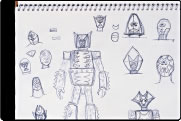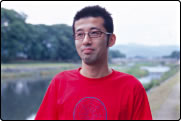   |
| At some point in childhood, all of us must have been swept up in the magical
world of make-believe while playing alone.
We were a special character in a situation known only to us.
At the age of 10, Tomohiro Yasui began constructing robots out of paper to
give form to his fantasy arena of wrestling robot fighters.
Twenty years have passed, and he continues to enjoy and explore this solitary sphere of make-believe.
His kami-robo look so animated and lifelike one might assume Yasui's dreamland is a reflection of reality. He says he imagines how his kami-robo would behave in certain situations and cope with certain consequences. And while playing with them, he thinks about which wrestlers he admires and those he despises. Though all that transpires is the product of his imagination, it seems like Yasui is only an observer of this turbulent, action-packed world. Wrapped up in our own dreamland, perhaps we all can construct such vivid simulations. Maybe such games help us to unconsciously figure out what kind of people we want to be and what is most important in life. Most of us abandon the world of fantasy as we age. But, once in awhile, our minds wander, taking us back to that place of infinite creativity. Maybe this is a way of simulating what is happening in the real world. |
   |
|
Yasui, the world's sole creator of kami-robo, began making original robots as a small boy. It was the TV animation "Mobile Suit Gundam" and professional wrestling that provided the greatest inspiration for his quest to create increasingly flexible, powerful and durable paper robots that could go round after round in the ring. During college, Yasui was a member of a wrestling club. He later became a costume designer for TV action-heroes and professional wrestlers. At present, he is a successful plastic-toy model designer, working out of his own office, Yasui Studio. Though over 30, he remains an avid kami-robo player. Yasui's private fantasy world of kami-robo wrestling came to light because of art director Katsunori Aoki, who periodically worked with him. Aoki believed there was something intrinsically interesting and compelling about kami-robo that would appeal to anyone. As such, he wanted to put together a project to take the kami-robo world public.
|